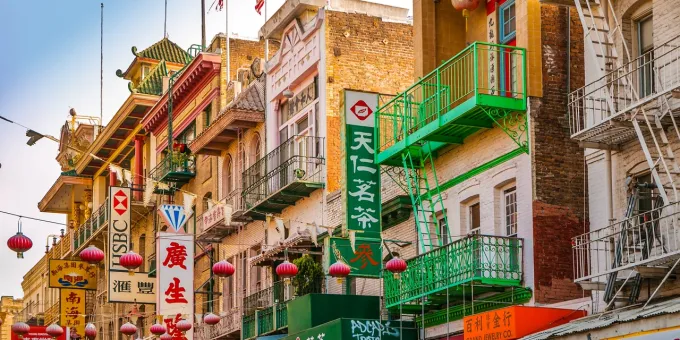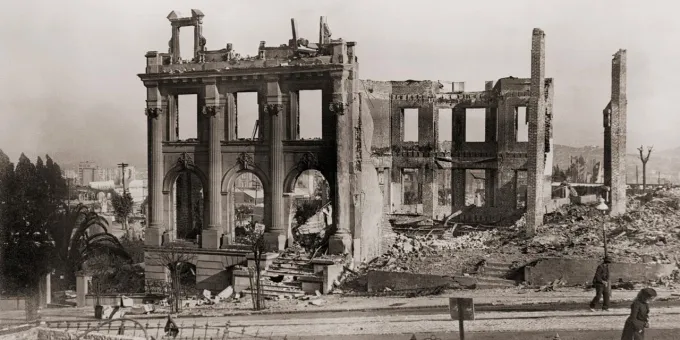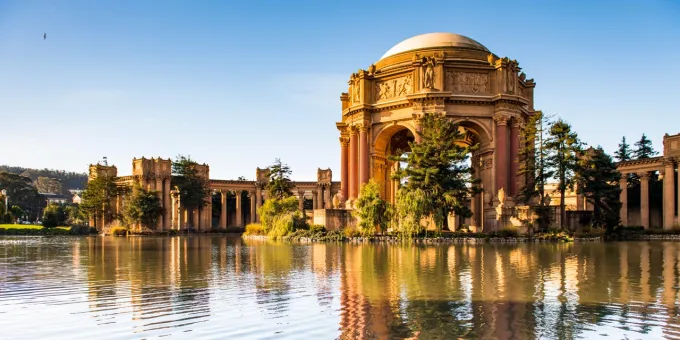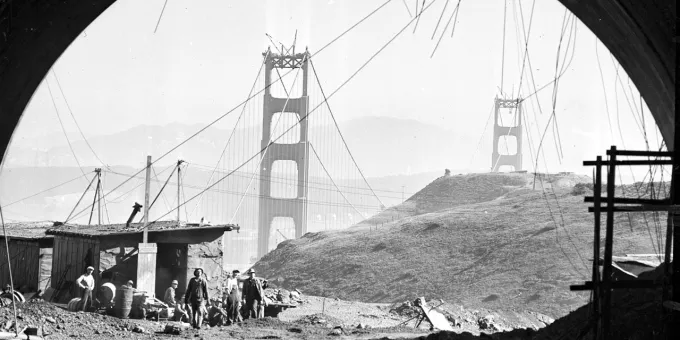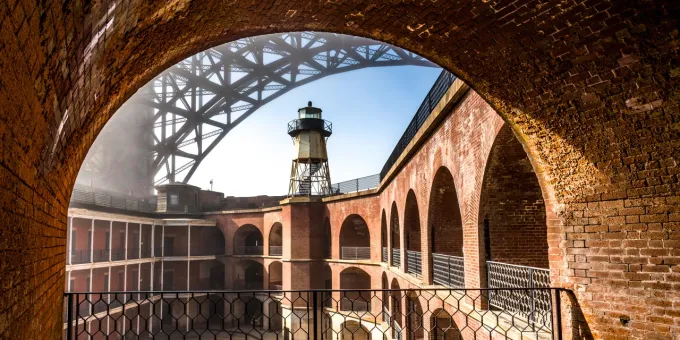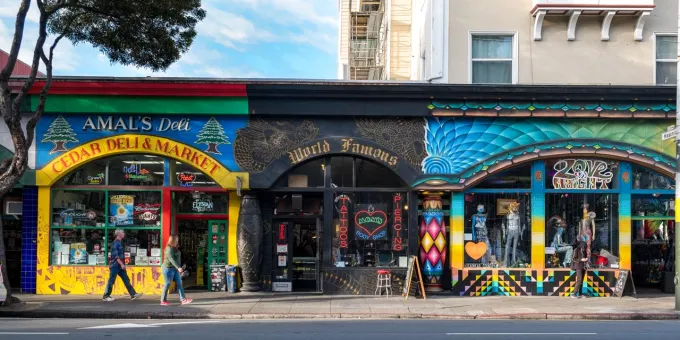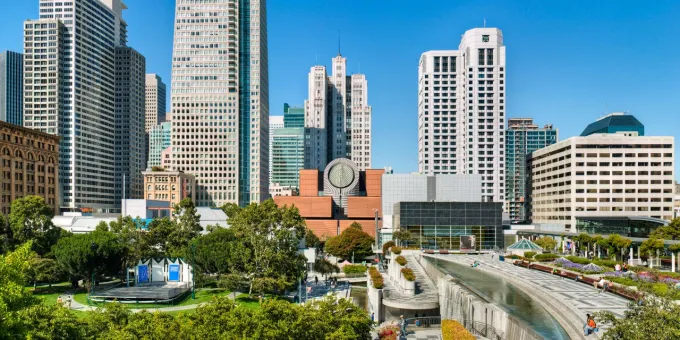San Francisco is a unique destination with a storied history that can be experienced through the many iconic landmarks found throughout the city. Major events, such as the 1849 Gold Rush and the 1906 Earthquake, played an outsized role in shaping the contours of the City by the Bay, and its location on the Pacific Ocean made it a strategic choice for a military base during both World Wars.
The Golden Gate City boasts a diverse culture, heavily influenced by its early Spanish and Mexican settlers and large Chinese population. The city is also the birthplace of the 1960s counterculture movement and was at the forefront of the LGBTQIA+ rights movement. Today, San Francisco is home to cutting-edge technology and innovation. Here is a list of historical locations to visit on a trip to San Francisco.
1776: Early History and Settlement
Why it’s a significant moment In San Francisco history:
Native American tribes have called the San Francisco Bay Area region home for more than 10,000 years. It was in 1776, when Spanish leaders (the first European settlers to arrive), established what would become San Francisco, naming the new encampment after the native Yerba Buena plant. In 1847, the city was renamed San Francisco to honor St. Francis of Assisi.
In 1776, the Spanish established the Presidio as a military stronghold. Today, it’s one of the city’s most popular and bucolic parks. The Spanish also founded Mission Dolores in 1776, one of the oldest still-standing buildings. And don’t miss Portsmouth Square, the location of the original Spanish settlement and the place where the American flag was first raised in the city.
1849: The Gold Rush
Why it’s a significant moment In San Francisco history:
The discovery of gold in California resulted in San Francisco’s population increasing from roughly 1,000 to nearly 25,000 people in the span of a year.
The population influx from the Gold Rush permanently altered San Francisco—most notably a major expansion of the city’s ports. The waterfront Embarcadero is rich with history as well as bustling bars and cafes. Visitors can watch the sea lions at Pier 39 or shop for gourmet foods at The Ferry Building. Chinese laborers migrated during the Gold Rush to work on the Transcontinental Railroad, forming the city’s robust Chinatown—an iconic neighborhood known for its authentic tea shops and restaurants. Visitors can learn more about Asian culture at the Asian Art Museum, home to one of the largest collections of Chinese Art outside of China. Even the city’s National Football League team, the San Francisco 49ers, is a reference to the Gold Rush era. Miners who came to California in search of gold were known as “forty-niners.”
1906: San Francisco Earthquake
Why it’s a significant moment In San Francisco history:
The 1906 San Francisco earthquake was one of the most devastating earthquakes in United States history. Approximately 80 percent of the city was destroyed, as buildings collapsed and citywide fires broke out and lasted for days.
The aftermath of the quake–which ranked a 7.9 magnitude on the Richter scale–took out roughly 500 city blocks. Many Italian Immigrants living in the South of Market (SoMa) neighborhood found themselves displaced after the earthquake and relocated to North Beach, which is often referred to as Little Italy. The earthquake also caused major damage to the city’s jails, but a small island close to shore was unscathed, leading to the creation of Alcatraz, one of the most famous prisons the world. Alcatraz closed in 1963 but tours of the penitentiary remain one of the most popular experiences in the region.
1915: Panama-Pacific International Exposition
Why it’s a significant moment In San Francisco history:
The 1915 Panama-Pacific International Exposition was a World’s Fair that brought more than 20 million visitors to San Francisco. Ruins from the 1906 earthquake were salvaged and repurposed as part of the foundation for the Exposition’s many sophisticated displays and structures.
The Palace of Fine Arts is one of the last remaining buildings constructed for the Exposition. It’s free to visit and walking tours are available. Visitors curious to see how the Palace may have looked when it was first built will want to check out the Legion of Honor, which is a replica of The Palace of Fine Arts in Paris and commemorates Californian soldiers who fought in World War I. Marina Green and Crissy Field, located in the Presidio, are also remnants of the 1915 Exposition. These two waterfront parks offer robust hiking trails, pristine beach areas, and stunning views of the Golden Gate Bridge.
1933: Golden Gate Bridge Construction Begins
Why it’s a significant moment In San Francisco history:
The iconic bridge, spanning the Golden Gate strait that connects San Francisco Bay and the Pacific Ocean, is one of the most recognized symbols of a city anywhere in the world. At least 100,000 people attended the groundbreaking festivities on Jan. 5, 1933, while the San Francisco Racing Pigeon Club sent forth 250 carrier pigeons with announcements of the news. More than four years later—April 19, 1937, to be exact—the roadway was complete.
The Golden Gate Bridge, which cost $27 million to construct, is a marvel of technical and engineering achievement that matches its physical beauty. When it opened, it was the longest and tallest suspension bridge in the world, with the main span stretching for 4,200 feet and rising 746 feet into the air. Each cable alone weighs 12,000 tons, consisting of 27,572 individual wires. The bridge is not to be missed— it’s a stunning visual on the horizon, and an even more impressive structure up close.
1941: World War II
Why it’s a significant moment In San Francisco history:
San Francisco was one of the largest ports utilized by the U.S. military to deploy troops and supplies to the Pacific Theater during World War II. The city also served as a major manufacturer of aircraft and naval ships.
During World War II, the American military established bases at the Presidio as well as on Treasure Island. Soldiers stationed at what is now Fort Point National Historic site guarded the Golden Gate Bridge from naval attacks. At Pier 45, visitors can hop aboard the USS Pampanito, a WWII submarine-turned-museum. They can also wander to Fisherman’s Wharf for a tour of the SS Jeremiah O’Brien Liberty ship that took part in the D-Day invasion. The War Memorial Opera House is another great option for those interested in military sites: It is the birthplace of the United Nations and where the 1951 peace treaty with Japan was signed.
1950s: The Beat Generation
Why it’s a significant moment In San Francisco history:
The Beat Generation, or beatniks, an anti-conformist youth movement, instilled a counterculture spirit in San Francisco that exists to this day.
Jack Kerouac, author of the generation-defining novel On The Road, and poet Allen Ginsberg were among the leading figures of the Beat Generation and called North Beach home. Beatniks rejected the materialism of the postwar era, embraced unconventional lives, and expressed themselves freely. To capture a bit of their bohemian spirit, visit Vesuvio Cafe, a popular hangout for writers and poets of the Beat Generation. City Lights Bookstore, which first published Ginsberg’s famous poem Howl, is next door and is a must-see. The Beat Museum, also in North Beach, is dedicated to preserving the memory of the Beat Generation.
1967: Summer of Love
Why it’s a significant moment In San Francisco history:
Nearly 100,000 young adults gathered in Haight-Ashbury during this time for an anti-war celebration of peace, love, and live music. The Summer of Love marked the unofficial transition from the Beat Generation to hippie culture.
The Haight-Ashbury district is known for streets lined with colorful Victorian houses and even more colorful residents. Numerous vintage clothing shops and boutiques located in this cute neighborhood feature iconic and timeless hippie fashion. Visitors will also find plenty of music shops, dive bars, and restaurants. Take a photo of the famous street sign at the corner of Haight and Ashbury streets or check out a concert at The Fillmore, which was a popular venue for local artists including The Grateful Dead and Janis Joplin.
1970s: Harvey Milk and the LGBTQIA+ Movement
Why it’s a significant moment In San Francisco history:
Harvey Milk lived in San Francisco’s Castro District and was the first openly gay politician to be elected to office in California. While serving on the Board of Supervisors, Milk played a pivotal role in passing a groundbreaking gay rights ordinance for the city, which banned anti-gay discrimination in employment and housing.
The Castro District was and remains a prominent symbol of LGBTQIA+ activism, a neighborhood that is especially festive in June during Pride Month celebrations. Visit the GLBT Historical Society that preserves the history of the LGBTQIA+ movement and The Rainbow Honor Walk, which features bronze plaques that recognize individuals who have positively impacted the LGBTQIA+ community. The Castro Theatre is a 100-year-old historic landmark where visitors can see eclectic films, music, and live performances. Read more about LGBTQIA+ travel in San Francisco.
1990s–2000s: The Dot-Com Boom
Why it’s a significant moment In San Francisco history:
Not unlike the Gold Rush, the promise of opportunity and wealth from the Dot-Com Boom caused people to flock to the Bay Area. Google, Apple, Meta, and Lyft are just a few of the many notable companies that call this hub of innovation their home. To this day, Silicon Valley and the tech industry continue to reshape San Francisco and the entire world.
The Dot-Com Boom was a significant time of growth and change for San Francisco’s SoMa neighborhood. The neighborhood’s industrial buildings now house start-ups, restaurants, and coffee shops. The Moscone Center underwent multiple renovations in the 1990s and is one the largest convention centers on the West Coast. The architecturally revered San Francisco Museum of Modern Art relocated to SoMa in 1995 near Yerba Buena Gardens, which was completed in 1993. Visitors will also want to take a stroll through Metreon, a high-tech, four-story shopping center in the heart of SoMa.
––
San Francisco is a vibrant city with loads of history worth exploring. Visit the Mission District with its Mexican roots and try an authentic Mission-style burrito. Head to the Tenderloin to grab a drink at one of the many speakeasies left over from the Prohibition era. Check out the Natural History Museum at the California Academy of Sciences, located inside Golden Gate Park. No matter where you go in San Francisco, you’re bound to discover another important piece of history.
